A live weekly radio adventure through Indiana history with host Nelson Price. Airs live on Saturdays from noon to 1 pm ET at WICR 88.7 fm in Indianapolis.
You can listen to WICR anywhere on your mobile device or at home on your smart speaker. Go to www.wicronline.org to listen live. You can also ask your smart speaker to "play WICR" OR "play 88.7 the Diamond".
February 18, 2023
Roberts Settlement in Hamilton County: its history and legacy
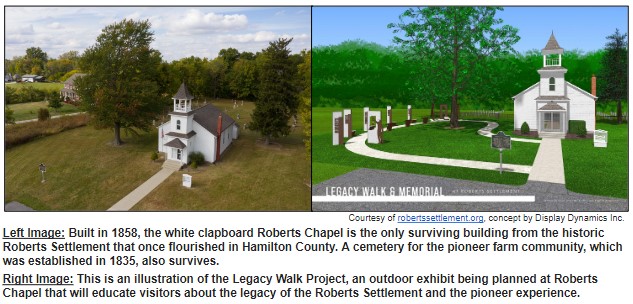
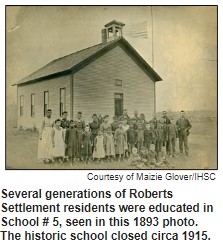 A white clapboard chapel with a steeple and a historic cemetery in northern Hamilton County are the sites of cherished annual events known as "homecomings" that draw people from across the country. They come to honor the Roberts Settlement, a historic farm community founded by free Black families in the 1830s who arrived from the South to start new lives on the Indiana frontier.
A white clapboard chapel with a steeple and a historic cemetery in northern Hamilton County are the sites of cherished annual events known as "homecomings" that draw people from across the country. They come to honor the Roberts Settlement, a historic farm community founded by free Black families in the 1830s who arrived from the South to start new lives on the Indiana frontier.
After initial challenges during its pioneer era when the community was isolated, the Roberts Settlement flourished for decades, with farm families of mixed racial heritage (including several families related by marriage) building Roberts Chapel in 1858, replacing its log predecessor. A highly regarded school, School House # 5, opened in 1877. The community peaked with nearly 300 residents on 2,000 gently rolling acres.
Today, only the chapel and the community's cemetery remain, but a Legacy Walk project is underway to create outdoor exhibits near the chapel. That's where descendants of Roberts Settlement families have returned for the massive "homecomings" that began during the 1920s. The 100th homecoming is planned for June 30-July 2.
As Hoosier History Live salutes Black History Month, Nelson will be joined by two studio guests who live in the Noblesville area and are descended from Roberts Settlement families. (The Roberts Settlement is located northwest of Noblesville near the Hamilton County town of Atlanta, Ind.) The guests will be:
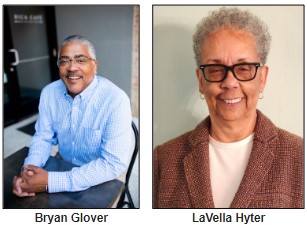
-
Bryan Glover, a retired businessman who is vice president of the Roberts Chapel Church & Burial Association, a nonprofit associated with the Roberts Settlement. Bryan grew up in Noblesville and is a civic leader in his hometown who serves on boards of organizations including the Noblesville Chamber of Commerce.
-
And LaVella Hyter, who grew up on a farm in the Roberts Settlement area and serves as president of the Roberts Chapel Church & Burial Association. Retired from a California-based business career that included work for Fortune 1000 companies, she serves on the board of Bethel AME Church-Noblesville.
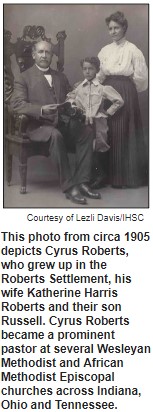
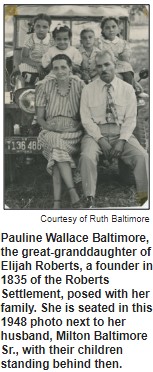 By 1920, the Roberts Settlement population had dwindled to less than 50 residents. Several factors influenced the decline, including economic challenges that confronted small farmers. But many residents of the Roberts Settlement or their descendants went on to distinguished careers; they included a Chicago-based surgeon who achieved national recognition as well as judges, educators and pastors. Before that, several residents of the Roberts Settlement volunteered for the Union Army during the Civil War by joining the 28th Regiment U.S. Colored Troops, the African American infantry from Indiana.
By 1920, the Roberts Settlement population had dwindled to less than 50 residents. Several factors influenced the decline, including economic challenges that confronted small farmers. But many residents of the Roberts Settlement or their descendants went on to distinguished careers; they included a Chicago-based surgeon who achieved national recognition as well as judges, educators and pastors. Before that, several residents of the Roberts Settlement volunteered for the Union Army during the Civil War by joining the 28th Regiment U.S. Colored Troops, the African American infantry from Indiana.
The settlement's history began in 1835, when three free African American pioneers arrived from the South and purchased homesteads in the Hamilton County wilderness. With choosing the site in part because it was near communities of Quakers, who were known to be supportive of Blacks. The pioneers (Hansel Roberts, Elijah Roberts and Micajah Walden) then brought their families to the area and, within five years, the settlement included about 10 families. They primarily came from North Carolina and Virginia; although they were living as free men and women in the South, they had become concerned about escalating tensions between whites and enslaved people, according to Southern Seed, Northern Soil, a book about early African American farm communities by historian Stephen Vincent.
According to a history of the Roberts Settlement on its website, its early years were "daunting and uncertain". Not only was the farm community in northern Indiana isolated, its growth was impacted by a major national depression during the late 1830s and early 1840s. But the opening in 1853 of a nearby railroad, the Peru & Indianapolis line, reduced the isolation and enabled Roberts Settlement residents much better access to farm markets. Several sources describe the 1850s through the 1870s as the "golden era" of the Roberts Settlement. Many of the residents were of mixed Black, Native American and white heritage.
After the 1870s, as older settlers died, their farms were carved up among their descendants, according to a video version of "Southern Seed, Northern Soil" about the Roberts Settlement that's available on YouTube. Small farming was becoming less economical; meanwhile, younger generations at the Roberts Settlement were enticed by jobs at factories and businesses in Noblesville, Indianapolis and other cities. School House # 5, which had been known for its academic rigor, closed in about 1915, according to Southern Seed, Northern Soil.
But the descendants did not want the settlement's significant role in African American history to be forgotten. So they began the massive annual homecomings in 1924. The Legacy Walk project is regarded as the next step in preserving the heritage.
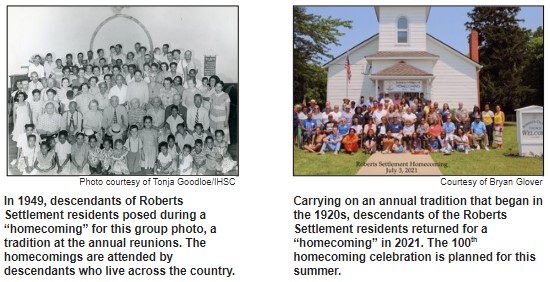

Your contributions help keep Hoosier History Live on the air, on the web and in your inbox!







